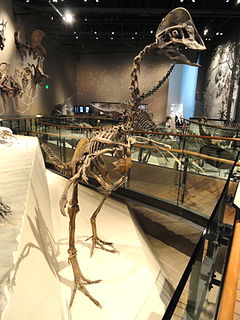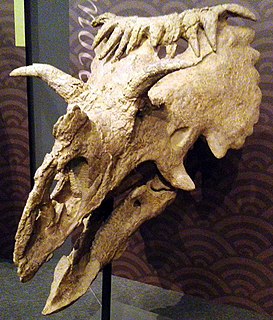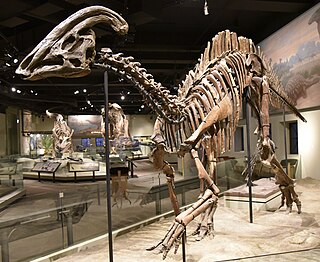 W
WBasilemys is a large, terrestrial trionychoid turtle that was from the Upper Cretaceous time period. In Greek, the "Basil (name)" means royal or kingly and the word "Emys" means turtle. Therefore, Basilemys means King Turtle. The stratigraphic subdivisions of the Upper Cretaceous include Cenomanian, Turonian, Coniacian, Santonian, Campanian, and Maastrichtian. Basilemys was mostly from the Campanian and Maastrichtian subdivisions of the Cretaceous time period and is considered to be the largest terrestrial turtle of its time. This extinct genus of land turtles belongs to the family Nanhsiungchelyidae. Occurrences of Basilemys have largely been reported in the North America region. It is interesting to note that the family Nanhsiungchelyidae made its first appearance in the Lower Cretaceous in Asia and we know from Basilemys that this family appeared in the Upper Cretaceous in North America. The North American populations of Basilemys are considered to be immigrants from Asia through the Beringia during the Upper Cretaceous. In an analysis made by Sukhanov et al. on a new Nansiunghelyid turtle from the Upper Cretaceous of Mongolia, it was demonstrated that Asian nanhsiungchelyids gave rise to the North American nanhsiungchelyids. One genus from the family Nanhsiungchelyidae, Zangerlia, is similar to Basilemys in terms of skull proportions. However, Basilemys has a more complex triturating surface that includes well-defined pockets on the dentary. Basilemys also has tooth-like projections on the triturating surface of the maxilla.
 W
WGryposaurus was a genus of duckbilled dinosaur that lived about 80 to 75 million years ago, in the Late Cretaceous of North America. Named species of Gryposaurus are known from the Dinosaur Park Formation in Alberta, Canada, and two formations in the United States: the Lower Two Medicine Formation in Montana and the Kaiparowits Formation of Utah. A possible additional species from the Javelina Formation in Texas may extend the temporal range of the genus to 66 million years ago.
 W
WHagryphus, is an oviraptorosaurian theropod dinosaur from the Upper Cretaceous Period of what is now Utah.
 W
WKosmoceratops is a genus of ceratopsid dinosaur that lived in North America about 76.4–75.5 million years ago during the Late Cretaceous period. Specimens were discovered in Utah in the Kaiparowits Formation of the Grand Staircase-Escalante National Monument in 2006 and 2007, including an adult skull and postcranial skeleton and partial subadults. In 2010, the adult was made the holotype of the new genus and species Kosmoceratops richardsoni; the generic name means "ornate horned face", and the specific name honors Scott Richardson, who found the specimens. The find was part of a spate of ceratopsian discoveries in the early 21st century, and Kosmoceratops was considered significant due to its elaborate skull ornamentation.
 W
WNasutoceratops is an extinct genus of ceratopsian dinosaur. It is a basal centrosaurine which lived during the Late Cretaceous Period. Fossils have been found in southern Utah, United States. Nasutoceratops was a large, ground-dwelling, quadrupedal herbivore with a short snout and unique rounded horns above its eyes that have been likened to those of modern cattle. Extending almost to the tip of its snout, these horns are the longest of all the members of the centrosaurine subfamily. The presence of pneumatic elements in the nasal bones of Nasutoceratops are a unique trait and are unknown in any other ceratopsid. Nasutoceratops, Diabloceratops, and Machairoceratops are the only three centrosaurine dinosaurs from the American southwest.
 W
WParasaurolophus is a genus of herbivorous ornithopod dinosaur that lived in what is now North America and possibly Asia during the Late Cretaceous Period, about 76.5–73 million years ago. It was an herbivore that walked both as a biped and as a quadruped. Three species are universally recognized: P. walkeri, P. tubicen, and the short-crested P. cyrtocristatus. Additionally, a fourth species, P. jiayensis, has been proposed, although it is more commonly placed in the separate genus Charonosaurus. Remains are known from Alberta (Canada), New Mexico and Utah, and possibly Heilongjiang, (China). The genus was first described in 1922 by William Parks from a skull and partial skeleton found in Alberta.
 W
WTeratophoneus is a genus of carnivorous tyrannosaurid theropod dinosaur which lived during the late Cretaceous period in what is now Utah, United States, containing a single known species, T. curriei. It is known from an incomplete skull and postcranial skeleton recovered from the Kaiparowits Formation. It was specifically named T. curriei in honor of Philip J. Currie.
 W
WUtahceratops is an extinct genus of ceratopsian dinosaur that lived approximately 76.4~75.5 million years ago during the Late Cretaceous period in what is now Utah. Utahceratops was a large-sized, robustly-built, ground-dwelling, quadrupedal herbivore, that could grow up to an estimated 7 m (23 ft) long.